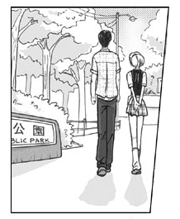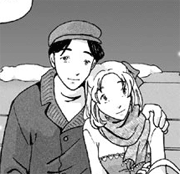Ever see the look on a comic fanboy's face when you show him his very first genuine shojo comic? And by comic fanboy, I don't mean a neanderthal for whom female comic characters conjure up images of a double D, bikini-clad broad striking a pose that wouldn't be out of place in Playboy. I'm talking about the well-read comic geek, who appreciates Alan Moore, Warren Ellis, Neil Gaiman, Los Hernandez Brothers, Ennis and Dillon, perhaps even some Rumiko Takahashi and Otomo Katsuhiro.
He'll start flipping the pages, looking for demons or samurai warriors or ninjas or a giant robot or some sort (any sort) of action scene. And slowly it dawns on him, he's holding in his hands the sequential art equivalent of Dawson's Creek. It's like his "Boys Only" club house has been redecorated with flowers and lace curtains in the windows.
Shojo, or Japanese girl/romance comics, have invaded the English-speaking world. Bookstores, and even libraries, are providing these comics to teenage girls (and others. Full disclosure: I own the all 18 volumes of the Peach Girl Series.) With all the translated imports out there, it's no wonder that Westerners are trying their hand at shojo-inspired comics, both in print and online. Some go one step further, creating comics that adhere to all aspects of the shojo style, both visual and cultural.
 Gina Biggs's Red String is one such online comic. Not only is it set in Japan, but Biggs has carefully researched Japanese customs and social mores, from festivals and architecture, to school uniforms and vacations schedules. She's also included footnotes at the end of each chapter to explain things Westerners might have missed. The character info page lists everyone's family name first, with the proper kanji and their meanings, as well as height in centimeters and blood type (the Japanese equivalent of your horoscope sign). The story mostly centers on Miharu Ogawa, the heroine, Kazuo Fujiwara, the boy her parents have engaged her to, and the various people trying to break them up. Despite the forced betrothal, the two have genuine feelings for each other, which develop over many chapters. The series, at 12 chapters, is not quite halfway done.
Gina Biggs's Red String is one such online comic. Not only is it set in Japan, but Biggs has carefully researched Japanese customs and social mores, from festivals and architecture, to school uniforms and vacations schedules. She's also included footnotes at the end of each chapter to explain things Westerners might have missed. The character info page lists everyone's family name first, with the proper kanji and their meanings, as well as height in centimeters and blood type (the Japanese equivalent of your horoscope sign). The story mostly centers on Miharu Ogawa, the heroine, Kazuo Fujiwara, the boy her parents have engaged her to, and the various people trying to break them up. Despite the forced betrothal, the two have genuine feelings for each other, which develop over many chapters. The series, at 12 chapters, is not quite halfway done.
 As with any comic genre, shojo has a particular look. It's not enough to be able to draw cute girls and bishonen (handsome guys) – although that certainly helps. While the character designs are not quite as polished as those of a professional Japanese comicker, Biggs more than successfully captures the feel of shojo. Each page is carefully shaded and screen-toned, with numerous background locations and lots of full body (not just head and shoulders) compositions. The characters are distinct and recognizable, even when they're in super-deformed or "cute" mode. But beyond these obvious touches, Biggss shows a strong understanding of the more subtle visual elements of a shojo story. Character fashions are wonderfully detailed, both reflecting the wearer's personality as well as just being nice to look at. Page composition is strong and not too crowded. Anatomy is also nicely done and Biggs pays close attention to body posture and expressiveness of people's hands. Such details give the comic a real Japanese feel, especially impressive considering that most Japanese comic artists have several assistants to help them.
As with any comic genre, shojo has a particular look. It's not enough to be able to draw cute girls and bishonen (handsome guys) – although that certainly helps. While the character designs are not quite as polished as those of a professional Japanese comicker, Biggs more than successfully captures the feel of shojo. Each page is carefully shaded and screen-toned, with numerous background locations and lots of full body (not just head and shoulders) compositions. The characters are distinct and recognizable, even when they're in super-deformed or "cute" mode. But beyond these obvious touches, Biggss shows a strong understanding of the more subtle visual elements of a shojo story. Character fashions are wonderfully detailed, both reflecting the wearer's personality as well as just being nice to look at. Page composition is strong and not too crowded. Anatomy is also nicely done and Biggs pays close attention to body posture and expressiveness of people's hands. Such details give the comic a real Japanese feel, especially impressive considering that most Japanese comic artists have several assistants to help them.
 The plot of Red String is an amalgamation of various classic shojo series – Marmalade Boy, with its wacky parents and love triangles is an obvious influence. This isn't necessarily a criticism as most Japanese shojo is fairly derivative. The story is well paced with enough momentum to keep you clicking the "next" button.
The plot of Red String is an amalgamation of various classic shojo series – Marmalade Boy, with its wacky parents and love triangles is an obvious influence. This isn't necessarily a criticism as most Japanese shojo is fairly derivative. The story is well paced with enough momentum to keep you clicking the "next" button.
Navigation is fairly straight forward although the main navigation menu is not available from the actual comic pages. There are also lots of neat extras. I especially like the full color art galleries.
While I respect the effort Biggss has made to create a truly Japanese shojo manga, the approach is not a complete success. The problem comes from setting a story completely within a separate culture, especially one as subtle and isolated as Japan's. Biggs's erudition, while well researched, is more a collection of facts than a deep understanding of Japanese culture and psyche. It feels less like she's telling her own story, and more like a remix of the various shojo stories she's read and studied. Take the character Makoto Yosue. He's introduced as an obnoxious rival for Miharu's affection, but is soon revealed as a ladies' man who has a softer side to his personality. It should be character development, but it comes off flat, with no real emotional connection with the reader. And, with a shojo comic, it's this connection between the readers and the characters that makes a good series into an unforgettable one.
There were several spots where I did feel empathy and understanding with the characters. This happened when Biggs focused on more universal human aspects of her story, such as a scene where Miruha and her mother make a mess of the kitchen, or when the gang travels to the zoo. In these scenes the characters truly come alive, assisted by Biggs's artwork and narrative style.
In the end, Red String is a wonderfully drawn comic with an interesting, enjoyable and fast-paced plot. The characters may be a bit two-dimensional, but the overall story is solidly shojo. And I, for one, have nothing to complain about that.
Kim Smuga-Otto is a staff contributor for Comixpedia. She is also the writer for several online comics ranging from hard science fiction to shojo/romance comics. They can be found at Studio Antithesis.
FYI: Red String should have won the WCCA award for the romance category.
I suppose if you’re a shojo afficiando then there may be some merit to your claims. However, I look upon Red String as something more than just a shojo. I see it as a fun and intriguing look into a girl’s life, set in a country other than my own. And as it’s written by someone who’s not Japanese, there is some detail that goes into helping the reader understand the characters from a Western point of view, detail that may be lacking with a traditional translated manga.
And while you see the characters as two-dimensional, you also view them through the rose-colored lens of a shojo fan. I look upon it with the eyes of a reader and fan (as well as reviewer) and thus compare the characters with those of other web comics.
Perhaps we’ve not seen as much development with some of the characters that we could have, but if you think of it, the story is primarily about Miharu. Kazuo, her friends, her cousin… those are suppliments to Miharu herself. We’ll learn more about them, we’ll watch them get more fleshed out… but it won’t be at the same speed that happens with Miharu.
But then again, I’ve been called “alarmingly upbeat” before about my reviews, so… *shrug* *chuckle*
Robert A. Howard, Tangents Reviewer
http://www.tangents.us